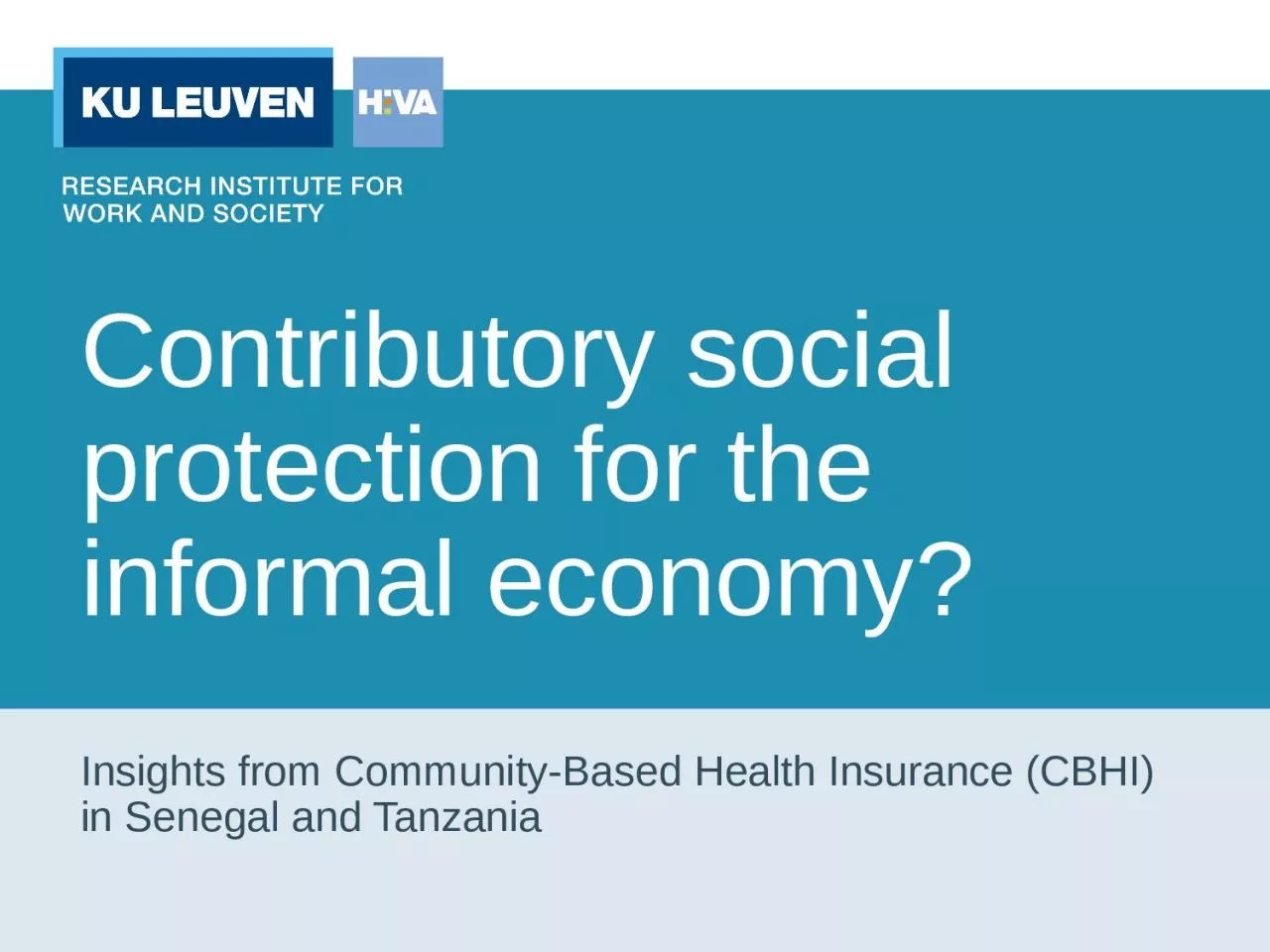

economy Insights from CommunityBased Health Insurance CBHI in Senegal and Tanzania Contributory social protection for the informal economy The coverage gap in the informal economy Case studies CBHI in Senegal and Tanzania ID: 1042927
Download Presentation The PPT/PDF document "Contributory social protection for the i..." is the property of its rightful owner. Permission is granted to download and print the materials on this web site for personal, non-commercial use only, and to display it on your personal computer provided you do not modify the materials and that you retain all copyright notices contained in the materials. By downloading content from our website, you accept the terms of this agreement.
1. Contributory social protection for the informal economy?Insights from Community-Based Health Insurance (CBHI) in Senegal and Tanzania
2. Contributory social protection for the informal economy?The coverage gap in the informal economyCase studies: CBHI in Senegal and TanzaniaWhat role for external actors? Recommendations and critical reflections2
3. The Coverage Gap(The lack of) Social protection in the informal economy3
4. The coverage gapILO (2018): 70% of global workforce is part of informal economyCoverage gap: people in informal economy remain largely excluded from statutory social (health) protection Clear obstacle on the road towards UHC4SDG target 3.8: Achieve universal health coverage, including financial risk protection, access to quality essential health-care services and access to safe, effective, quality and affordable essential medicines and vaccines for all.
5. Closing the coverage gapFocus on non-contributory schemes BUT limitations due to:Limited fiscal revenuesAdministrative challengesLack of political supportWhat role for contributory social protection that mobilizes resources from within the informal economy? How can we reach out to the informal economy?5
6. Reaching out to the informal economy: challengesPoverty, low and irregular incomesDiversity different needs and concernsLack of clear representation Lack of support from employersInformal systems of social protection6
7. Case studies: CBHI in Senegal and TanzaniaHow do CBHI-schemes reach out to their target population – the rural poor and people in the informal economy?7
8. Community-Based Health InsuranceKey characteristics:Prepayment schemes that pool health risks at community levelRelies (at least in part) on membership contributionsVoluntary membershipNot-for-profitTypically target rural/informal economyChallenges with regards to enrolment and revenue collectionHow do CBHI-schemes deal with challenges in the field of recruitment and revenue collection?8
9. Case 1: SenegalLong history of CBHI (Mutuelles de santé)Long history of Belgian support for CBHIMacky Sall (2012): “Achieve UHC by 2022” CBHI as key instrument for reaching out to ‘le monde rural et le secteur informel’Government subsidies Complex institutional architecture that revolves around mutuelles de base (1 per commune)9
10. Case 1: Senegal10
11. Case 1: SenegalMutuelles facing massive challenges:Difficulties to attract and retain new members = low autonomous capacity for revenue mobilizationMajor problems with payment of subsidies and the weakness of overarching support structures = lack of external financial support11
12. Case 2: TanzaniaCommunity Health Funds (CHF) as a reaction to liberalization of health care sector (1990s)Government-led and -subsidized scheme12
13. Case 2: TanzaniaProblems with scheme uptake (9,2% on average)Now: ‘Improved CHF’ pilots Redesigning the scheme:Improved management structures Increased premium pricesImproved benefit packagesGovernment subsidies maintained Involvement of private sectorWork with private health care facilitiesWork with NGOs: HPSS (Dodoma) and PharmAccess (Kilimanjaro) 13
14. Case studies of 2 CHF-pilots14 Improved CHF (CHF iliyoboreshwa) – DodomaImproved CHF (iCHF) – KilimanjaroPremium price10,000 TSH (5USD) per household (max. 6 members) per year30,000 TSH (15USD) per household per year Benefits package Primary health care at any public facilities (dispensaries and health centers) within the region.Primary health care with referral and hospitalization (up to 3 days) at two selected public and/or private facilities within the district. Reimbursement mechanism ClaimsCapitationOwnership/ Management Owned and managed by local government (district councils). The redesigning process was supported by HPSS project. Co-managed by NHIF (managing finances), PharmAccess (provide technical support) and district councils (conduct awareness campaigns and appoint enrollment officers through village governments).
15. Case studies: 2 CHF pilotsIncreased awareness about health insurance Increased enrollment? Cumulative enrollment of about 20% Dropouts remain a challenge (50%)Actual enrollment below 10%Problems with government subsidiesIntroduction of quasi-mandatory elements:Automatic registration of cash transfer recipientsCHF-membership as prerequisite for access to health care in public facilities Social pressure to enroll (from political leaders and local government authorities)15
16. Synthesis of case studiesCBHI integrated into national strategies for UHC Move away from genuine CBHI?Lack of government support (despite promises) Continued importance of stable and autonomous capacity for recruitment and revenue collectionBUT critical challenges remain due to:Poverty; low and irregular incomes Geographical remotenessDifficulties reaching particular target groupsDiversity in rural/informal economy Absence of decent health care services16
17. Coping strategiesProactive recruitment strategiesFlexible enrollment and revenue collection:Alternative groups and indidivual enrolmentPayment in installmentsMobile paymentsDeconcentration of recruitment and collection17
18. Coping strategiesProfessionalization: reliance on trained (and salaried?) staff ‘Couplage’: couple health care to other services Work through local social networksMobilize support from politicians BUT instrumentalization18
19. What role for external actors?Recommendations and critical reflections19
20. Recommendations(1) Targeted technical and financial support for more effective (professional?) recruitment and revenue collection (2) Politically smart interventions that mobilize political support while minimizing risk of instrumentalization(3) Develop comprehensive approach that:Looks at supply sideMinimizes fragmentation in social (health) protection20
21. Participatory planning- and assessment tool21
22. External support and fragmentation22
23. External support and fragmentationSenegal: Belgian actors supporting both approaches (mutuelles vs UDAM) Tanzania: different (competing?) pilots supported by different external actorsIs there room for a ‘rational approach’ that builds on combined strengths of both approaches? What could such an approach look like? How can different stakeholders contribute to its implementation?23
24. THANK YOU